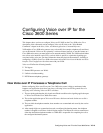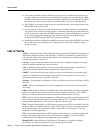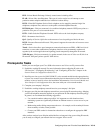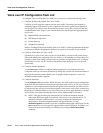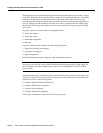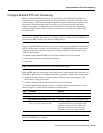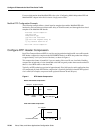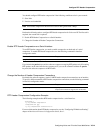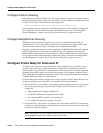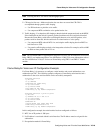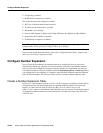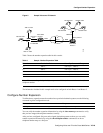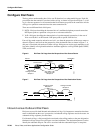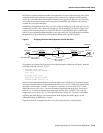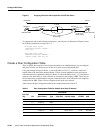
Configure IP Networks for Real-Time Voice Traffic
Configuring Voice over IP for the Cisco 3600 Series VC-17
(b) VoIP—Dial peer describing the characteristics of a packet network connection; in the case
of Voice over IP, this is an IP network. VoIP peers point to specific VoIP devices. To
minimally configure a VoIP peer, you need to configure the following two characteristics:
associated destination telephone number and a destination IP address. Use the
destination-pattern command to define the destination telephone number associated with
a VoIP peer. Use the session target command to specify a destination IP address for a VoIP
peer.
Refer to the “Configure Dial Peers” section additional information about configuring dial peers
and dial-peer characteristics.
5 Optimize Dial Peer and Network Interface Configurations
You can use VoIP peers to define characteristics such as IP precedence, additional QoS
parameters (when RSVP is configured), CODEC, and VAD. Use the ip precedence command to
define IP precedence. If you have configured RSVP, use either the req-qos or acc-qos command
to configure QoS parameters. Use the codec command to configure specific voice coder rates.
Use the vad command to disable voice activation detection and the transmission of silence
packets. Refer to the “Optimize Dial Peer and Network Interface Configurations” section for
additional information about optimizing dial-peer characteristics.
6 Configure Voice Ports
You need to configure your Cisco 3600 series router to support voice ports. In general, voice-port
commands define the characteristics associated with a particular voice-port signaling type. voice
ports on the Cisco 3600 series support three basic voice signaling types:
(a) FXO—Foreign Exchange Office interface
(b) FXS—The Foreign Exchange Station interface
(c) E&M—The “Ear and Mouth” interface (or “RecEive and TransMit” interface)
Under most circumstances, the default voice-port command values are adequate to configure
FXO and FXS ports to transport voice data over your existing IP network. Because of the inherent
complexities involved with PBX networks, E&M ports might need specific voice-port values
configured, depending on the specifications of the devices in your telephony network. For
information about configuring voice ports, refer to the “Configuring Voice Ports” chapter.
7 Configure Voice over IP for Microsoft NetMeeting
(Optional) Voice over IP can be used with Microsoft NetMeeting (Version 2.x) when the
Cisco 3600 series router is used as the voice gateway. Refer to the 'Configure Voice over IP for
Microsoft NetMeeting” section for more information about configuring Voice over IP to support
Microsoft NetMeeting.
Configure IP Networks for Real-Time Voice Traffic
You need to have a well-engineered network end-to-end when running delay-sensitive applications
such as VoIP. Fine-tuning your network to adequately support VoIP involves a series of protocols and
features geared toward Quality of Service (QoS). It is beyond the scope of this document to explain
the specific details relating to wide-scale QoS deployment. Cisco IOS software provides many tools
for enabling QoS on your backbone, such as Random Early Detection (RED), Weighted Random
Early Detection (WRED), Fancy queuing (meaning custom, priority, or weighted fair queuing), and
IP Precedence. To configure your IP network for real-time voice traffic, you need to take into
consideration the entire scope of your network, then select the appropriate QoS tool or tools.



